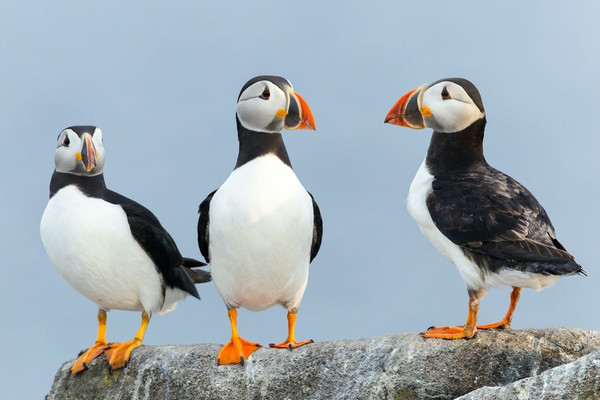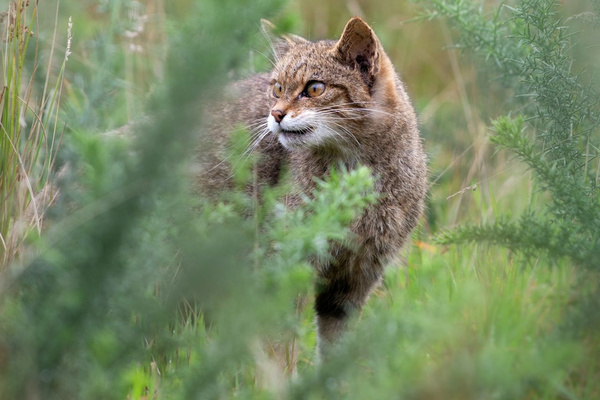Pine Marten
The Best of Scotland’s Wildlife
 By Dominic Couzens
By Dominic Couzens16th February 2021
Dominic is a Naturetrek tour leader and one of Britain's
best known and most prolific natural history writers.

Hermaness, on the Shetland Island of Unst, is as far north as you can reach in Britain, and it too has huge seabird colonies. It is probably most important for its 1,000 pairs of Great Skuas, the third largest colony in Europe and 4% of the world’s population. However, the cliffs and slopes here also have 20,000-40,000 breeding pairs of Puffins and 26,000 pairs of Gannets, as well as the usual suspects such as Guillemots, Razorbills, Shags, Cormorants and Kittiwakes. There are also, of course, Rock Pipits, a bird essentially confined to Britain and Scandinavia.
These are only two of the dozens of significant seabird colonies in Scotland. Others visited by Naturetrek include the Treshnish Islands, near Mull, and Noup Head on the mainland of Orkney. Scotland is the major British headquarters of the Black Guillemot, which is less of a cliff dweller than a low, rocky island dweller. At all these colonies, the din and the smell, as well as the sight of thousands of seabirds coming and going, makes a visit very special. A truly large colony is no less than one of the world’s great wildlife spectacles.
The waters that surround seabird colonies aren’t only good for seabirds, of course, but also support excellent populations of sea-mammals, both seals and cetaceans. Most people greatly underestimate just how good the UK is for these, and Scotland in particular. For example, the Grey Seal is an internationally restricted species, and the 182,000 animals in Britain represent about 40% of the world’s population. Although this species is found around the seas of the UK, about 88% of the numbers are in Scotland, especially Orkney and the Outer Hebrides. On almost any tour around the Scottish coast you are likely to see both Grey and Common Seals. Cruising around the Inner Hebrides, including Mull, Islay or Jura, you simply cannot miss them.
By their very nature it is much harder to see cetaceans. Nevertheless, the Moray Firth (visited on the ‘Speyside in Spring’ tour) is probably the best land-based site in Britain to see Bottlenose Dolphin, while any tour around Mull and the waters of The Minch are perfect locations for seeing Harbour Porpoise. Minke Whale is a summer visitor to these waters, and although you normally need to get on a boat to catch a glimpse of one, they are reasonably common. Other species occur, and the more time you spend on the water the more likely you are to see the likes of Atlantic White-sided Dolphin and Risso’s Dolphin. The iconic Orca is mostly a Northern Isles speciality, especially Shetland.
The islands of Scotland hold other significant treats. One of the most distinctive – and delightful – is a habitat, machair, which is only found worldwide in western Scotland and western Ireland. It is calcareous sand-dune grassland formed principally by the debris of shattered seashells, and in summer it blooms with a wondrously rich flora (up to 45 species of plants per square metre) of great abundance and colour, often including thousands of orchid spikes. Insects abound, including the very last Great Yellow Bumblebees in Britain. Some types of machair encompass wet grassland and tussocks, and within these waders such as Dunlin and Redshank breed, while in some places Corncrakes breed. Machair is abundant in the Outer Hebrides, with some on Islay (where Choughs use it for feeding) and the north-west mainland of Scotland.

Another major Scottish habitat is bog, of which there are several kinds, merging into moorland in some areas and forest edge in others. This is a major habitat of wading birds, such as Dunlin, Golden Plover, Curlew and much else, including some extremely rare flowers. There are many places in Scotland with this kind of tapestry of habitats. Further north, in Shetland, moorland alternates with pools and provides habitat for such rarities as Red-necked Phalaropes and Whimbrel, while Red-throated and Black-throated Divers breed in smaller and larger lakes respectively. In spring, bogs may resound to the sounds of waders: the ecstatic bubbling of Curlew, the “referee’s whistle” of Dunlin, the ethereal, mournful whistles of Golden Plover and the drumming of Snipe.
Most people’s impression of Scotland is of a beautiful, but rugged place, often with a somewhat melancholy scenery of severe slopes and scoured-out valleys with heavy peat, heather and bracken, all set off with a diet of ever-changing wind, rain and mist. The low human population adds to the sense of isolation. For many people, this quietness is a large part of Scotland’s attraction, and adds to the enjoyment of its wildlife. A popular component is an impressive roll call of raptors. Scotland has a very healthy population of Golden Eagles, as well as many introduced White-tailed Eagles, the latter of which can be seen on Mull to advantage as fish are thrown out to them from boats. There is a newly introduced population of Red Kites, as well as Peregrines, Merlins, Hen Harriers and Short-eared Owls.
The lonelier parts of Scotland also have a superb mammal fauna, and one corner, Ardnamurchan, is generally regarded as the finest place for mammals in Britain. It is also probably the only place where visitors have even the remotest chance of seeing one of our last remaining Scottish Wildcats. Here on the beaches, you are likely to run into Otter, which here is as much a sea dweller as a river or marshland dweller and more diurnal, too, and thus is easier to encounter. It is also common on the Inner Hebrides, such as on Mull, Jura and Islay. Ardnamurchan also has Roe, Fallow and Red Deer, the latter in autumn providing one of the great sights and sounds of British wildlife as they rut and roar. The woodlands and gardens also allow visitors to see another highly desirable species, the Pine Marten, which comes to feeders. Offshore, both Bottlenose Dolphin and Harbour Porpoise are reasonably common. On a good day, you could see 10 or more species of mammals.

One of Scotland most famous corners is the Cairngorm region, which offers some of Britain’s highest mountains and one of its most famous forests. The Caledonian Pine Forest, a natural vegetation that once covered an estimated 15,000 square kilometres of the Scottish Highlands, is home to a unique (for Britain) set of wildlife, including Crested Tits, (reintroduced) Capercaillies and a phalanx of Crossbills, some of which show a bill size adapted to Scots Pine cones, generally regarded as enough to make them Britain’s only endemic bird species. The many other treasures in these woods include the Black Grouse, Red Squirrel (common in much of Scotland), Chequered Skipper, Kentish Glory (moth) and the Twinflower. The nearby heathery slopes and hills are home, coincidentally, to the widespread Red Grouse, a bird that was once considered to be Britain’s only endemic bird; ours is now considered a distinctive race.
The many lakes in the Cairngorm region and Speyside are superb in their own right, providing chances to see Osprey (such as at Loch Garten, where the famous pair re-settled in Scotland in 1954), Slavonian Grebe and Goldeneye. Seeing grebes here in their magnificent breeding plumage is a very different experience to the black-and-white blobs you see offshore down south.
Everybody has heard the blanket term “Scottish Highlands”, and at times the two names seem almost synonymous – if you’ve been to the Highlands, everyone knows you went to Scotland. And in many people’s minds, Scotland is synonymous with mountains. On a continental scale, our “mountains” are minnows, with Ben Nevis (near Fort William) the highest at a mere 1,345m. Yet the wildlife and the climate conspire to make these hills seem taller than they are. The Ptarmigan, arguably the world’s most rugged bird which lives permanently in Greenland at 80° north, adds kudos with its presence. In the far north-west of Scotland, it lives almost at sea level. Snow Buntings also have an outpost on the high tops here, way to the south of their normal range, and there are a number of Arctic plants here, too, such as Dwarf Willow, Alpine Clubmoss and Moss Campion, surviving on summits blasted by winter gales and blizzards. The gorgeous Dotterel breeds on these stony plateaux. The Mountain Hare, another extraordinarily hardy animal, and our only native member of its family, also scratches a living in the Scottish Highlands. It lives in a continuing tension with its main predator, the equally hardy Golden Eagle, which has been observed flying severe gale force winds.

Further south, however, is a very different Scotland. Most of the population lives in the central band between Glasgow and Edinburgh, and in the lowlands, there is farmland not dissimilar to the rest of the UK. Yet even here there is exciting wildlife to see, especially around the great estuaries such as the Firth of Forth and the Solway.
A few Scottish sites come into their own in the winter, profiting from the great southward movements of Arctic breeding birds. Although Scotland is generally colder than England, it is still temperate compared to much of continental Europe and is also decidedly damp. The lakes and waters often don’t freeze, and this makes them attractive to birds such as geese; Britain, and Scotland in particular, is one of the best places for wild winter geese in the world. The headquarters is on the island of Islay, in the Inner Hebrides, which hosts 40,000 Barnacle and 10,000 Greenland White-fronted Geese during its autumn peak; the spectacle can be so astonishing, and so visceral, that you sometimes wonder if you have overdosed on the famous local whisky. Meanwhile the Solway Firth, not far to the south, provides winter refuge for another 30,000 Barnacles, plus Pink-footed Geese and Whooper Swans. The Scottish coasts, from the Moray Firth to the Solway, are also fabulous for wintering seaducks such as Long-tailed Ducks, Scoters and Goldeneye. These join wintering grebes and divers to provide mouth-watering spectacles for those who enjoy seawatching.
Of course, you can seawatch in England and Wales, too. Yet Scotland is just a little easier and better. And if anything, this encapsulates the difference between the two countries, and why a visit to Scotland is likely to bring wildlife delights in every corner.
View holidays to Scotland



 Loading search...
Loading search...